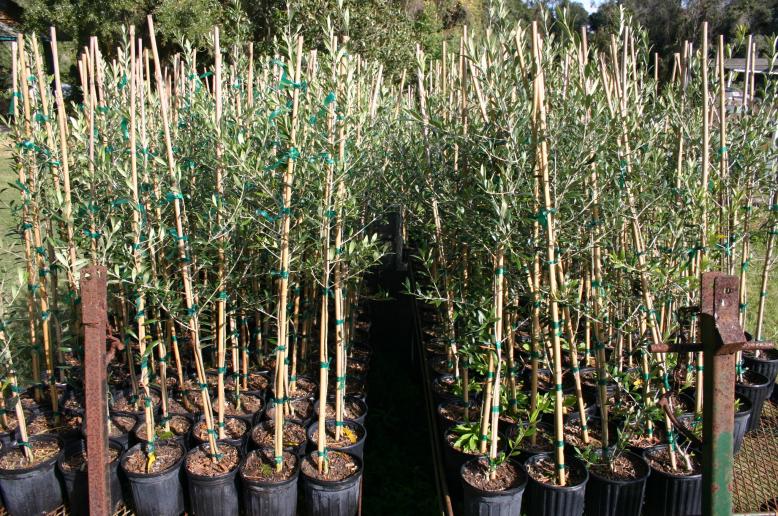Olive Production
On February 2, 2016, I visited John Fall’s olive grove in Dade City. His one acre of three-year old trees and one acre of two-year old trees have made a remarkable turn-around after having Quality Green test his soil and leaf tissue and then following the resulting recommendations.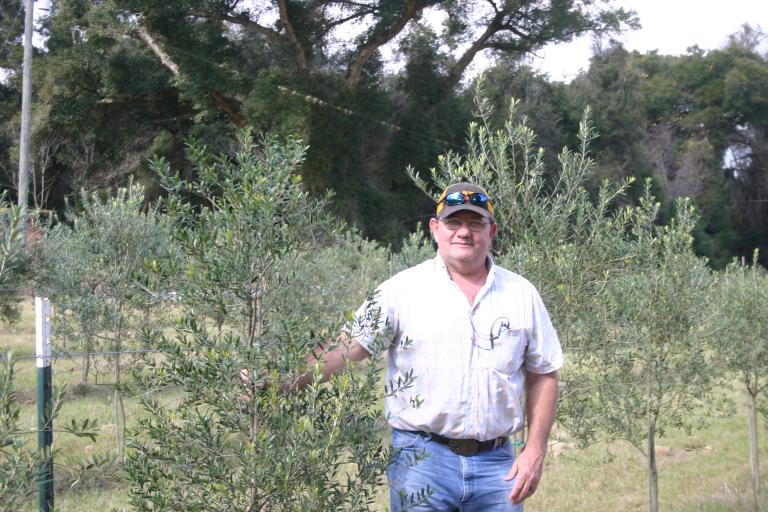
John Falls said that he is very happy with how well his trees are performing now and he is looking forward to picking his first olives this August.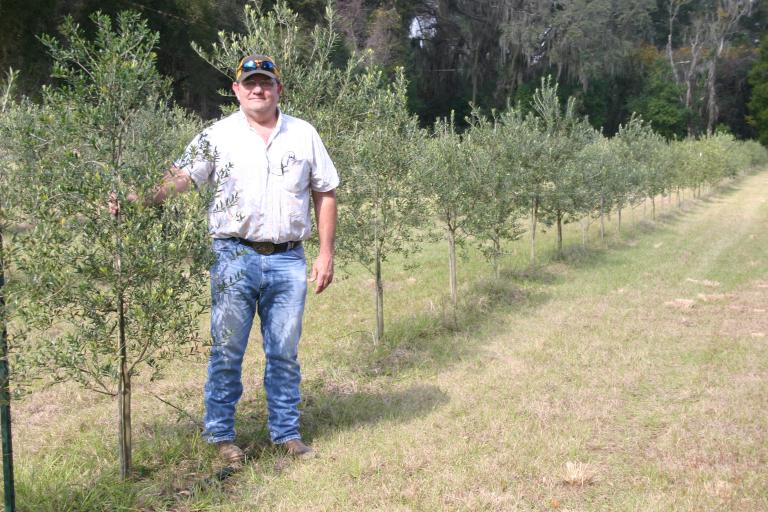
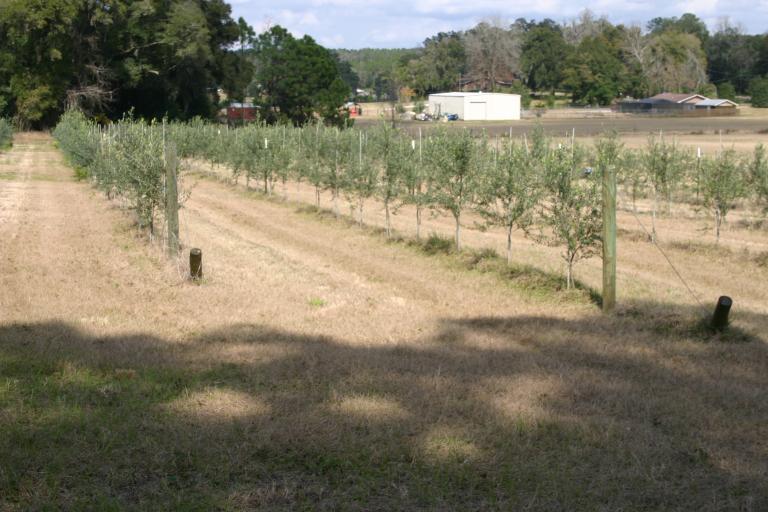
Above: John Fall’s 2-year old olive trees are getting off to a fast, healthy start.
During the week of January 18-22, 2016, Co-owner Allen Day and I visited three olive groves that Quality Green helped to start. All three picked olives in 2015 and all three growers are following our recommendations regarding cultural practices and fertilization. Scroll down to see photos and information about the groves. Other groves we helped start also had olives, e.g., Robin Vick in Ocala, Florida and Jerry Stilling in Oak Hill, Florida. Enjoy the photos:
Be sure to scroll down below the photos for detailed information about how to grow olives professionally.
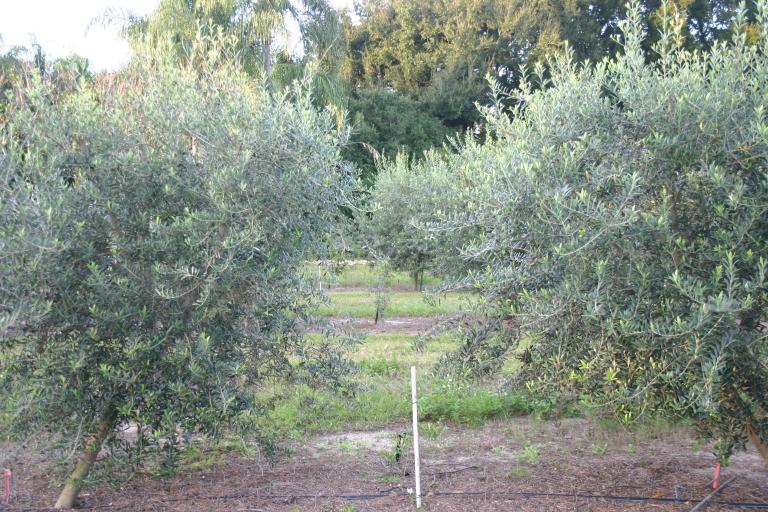
The olive grove in Winter Haven owned by Steve Oliva is looking terrific.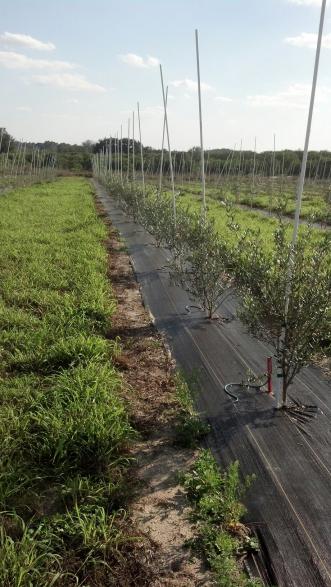
Jim Tschida’s grove in Haines City, Florida two years ago. The grove was first planted in early 2013 with a follow-up planting of additional trees in 2014. Photo taken in 2014.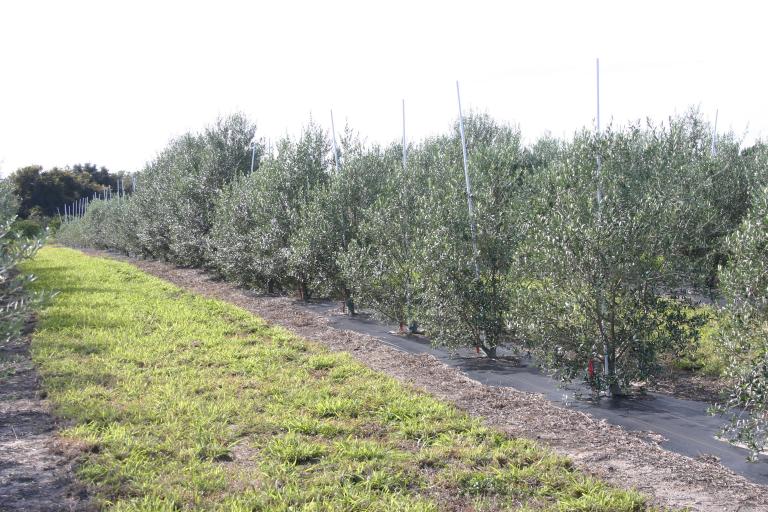
Jim Tschida’s grove as of January 20, 2016. Some trees are two years old. Others are three years old. The key secrets: our soil testing & leaf tissue analysis, lots of dolomitic limestone with a resulting alkaline pH between 7.2 – 7.5, low nitrogen, high potassium, Azomite® (O.M.R.I. listed organic volcanic pumice) with 65% available silicon dioxide, amino acids/seaweed (Ascophyllum odosum), no fertilizer between July and January. Liquid amino acids & seaweed and our 3-0-5 Fertilizer in January, April, and June (based on 50 pounds total per season of nitrogen per acre of rooting area); mild pruning through year 3, then in the 4th year, hard pruning of every other branch or every other side of the tree year to year to 12-18″ stubs about the first of September or right after picking the olive fruit, along with topping the trees to 9′ tall; (fruit is produced on the previous season’s new growth) skirting to 18″ of bare trunk in year 4; calling and talking with me at 386-837-3878. 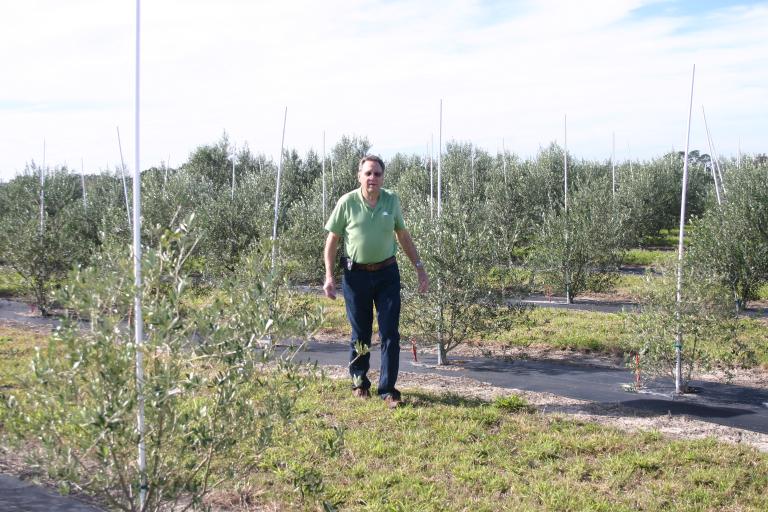
Quality Green Co-owner Allen Day in Jim Tschida’s two-year old Arbequina olive trees. The three-year old trees are in the background. Photo taken January 20, 2016.
A close-up of Jim’s 3-year old olive trees.
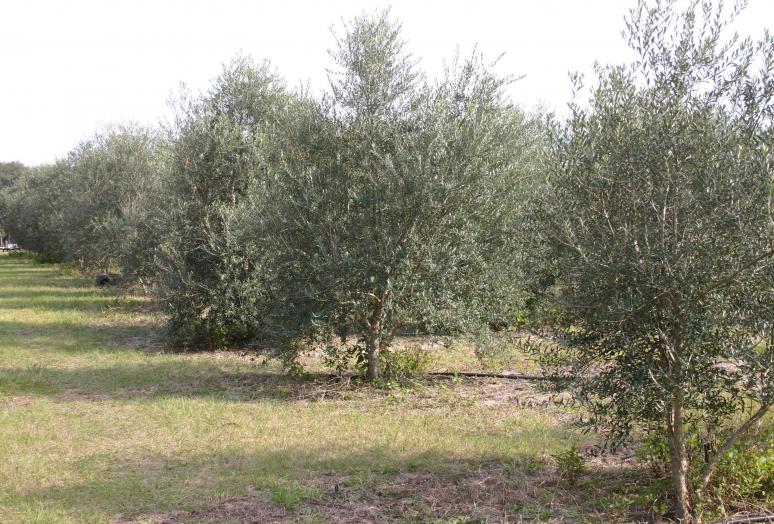
Above: Dr. Michael McDonough’s grove in Pierson, Florida is looking great looking from the north side. Last year his olives were pressed for oil in Georgia. Now there are olive presses/mills much closer in central Florida. The trees are receiving volcanic minerals & fertilizer this month. Note that the trees are ready for hard pruning this year to make them more productive. Photo taken January 21, 2016. Scroll down to see more photos and detailed infomation about growing olives. Click on the other Olive tabs on the left for more information regarding olives trees and how to make valuable (and super healthful) olive leaf extract.
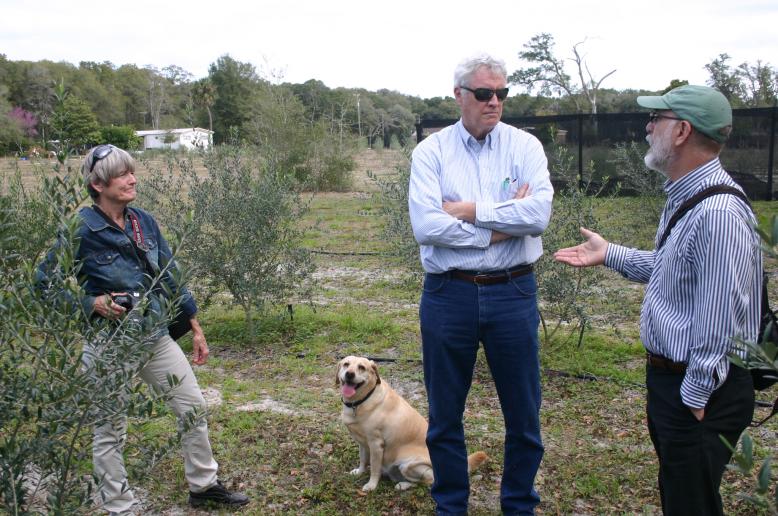
Above: Dr. McDonough’s grove on February 1, 2012. Dr. Louise Ferguson, Ph.D. (left) and Paul Vossen (right), from the University of California and California Extension were visiting to help jump-start the olive industry in Florida.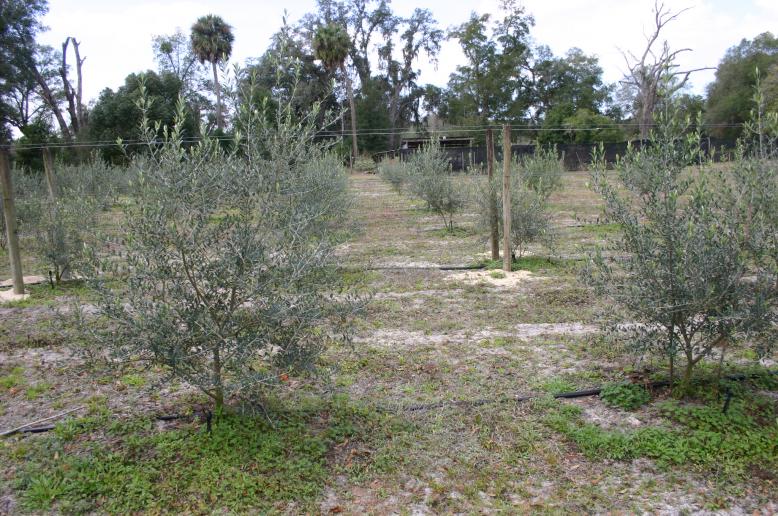
Above: Another look at Dr. McDonough’s grove on February 1, 2012.
More photos below of the grove on January 21, 2016: 
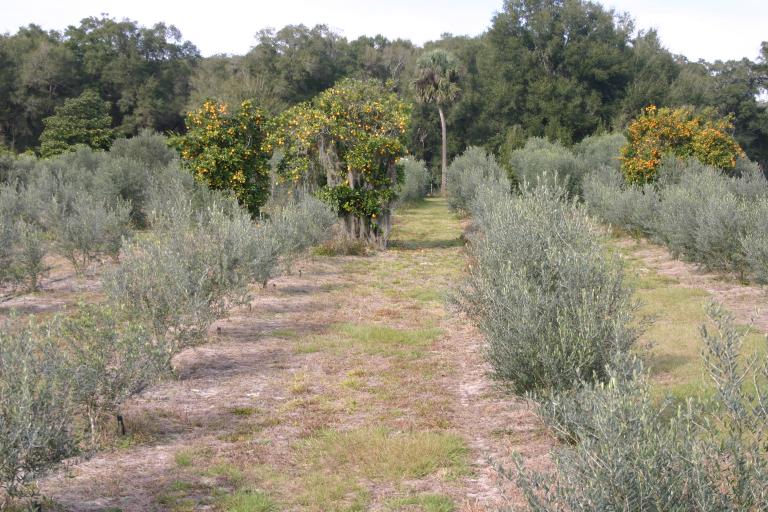
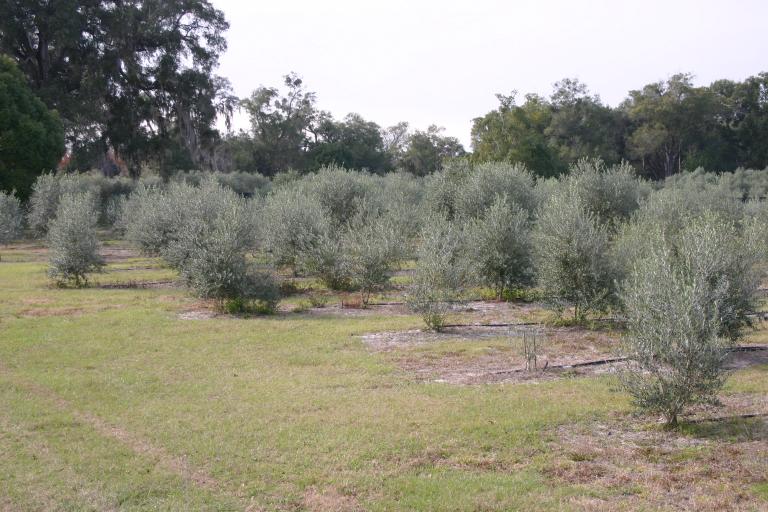
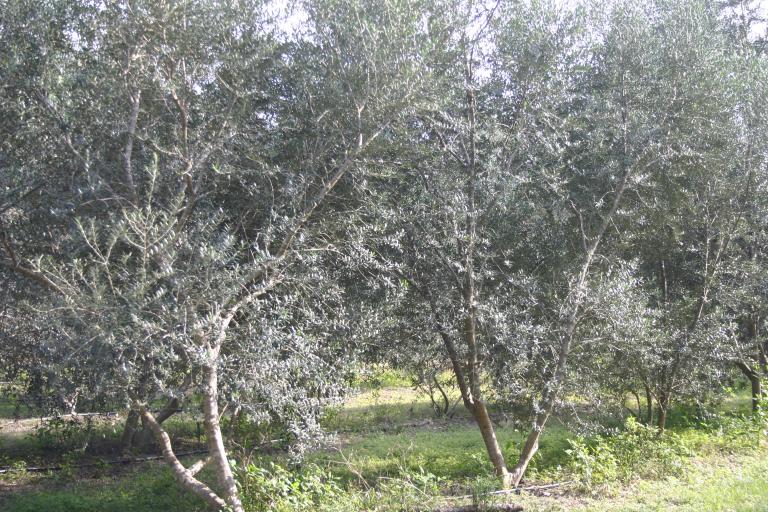
Above photo: the olive trees in most of the grove are ready for a hard pruning this year (2016).
July 31, 2014: Today, I took photos of Jerry Stillings olive trees when I went to visit his grove in warm Oak Hill: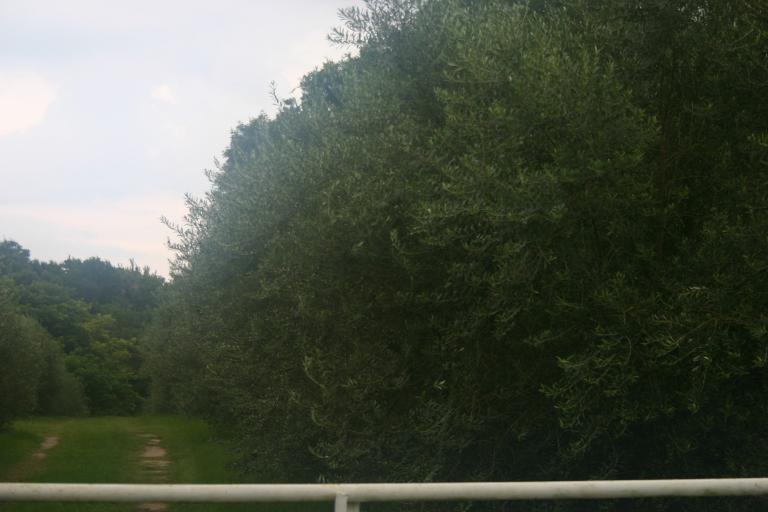
Look at these BIG Arbequina olive trees in only several years!
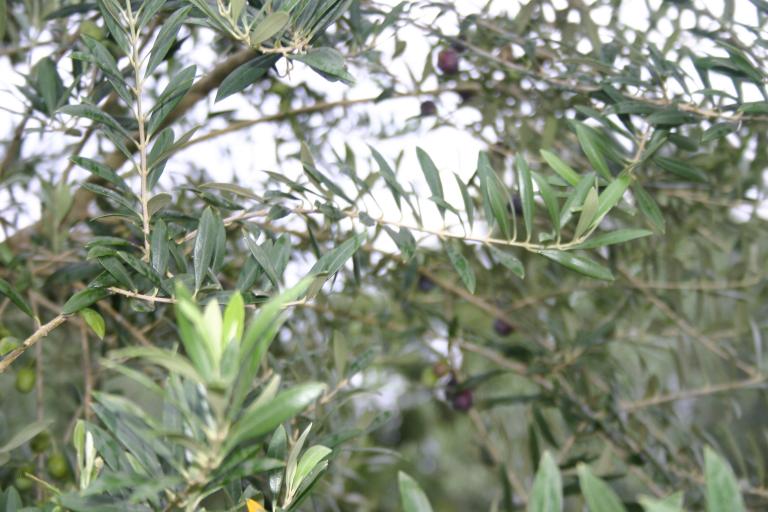
Look at the olives on the trees. Most are green, but some are already ripening. This location is very close to Mosquito Lagoon in Oak Hill on a sand hill. Winters are warmer here than inland Volusia County.

Above: Yes, we have big olive trees that went through the winter at the nursery in DeLand and they have lots of fruit.
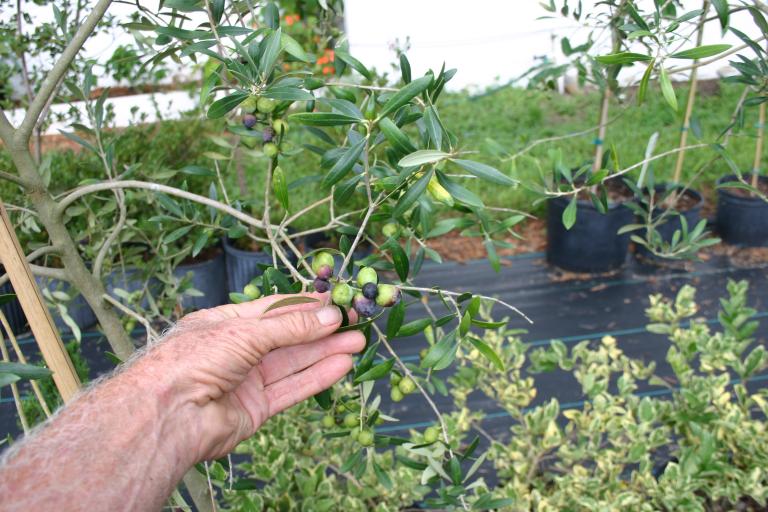
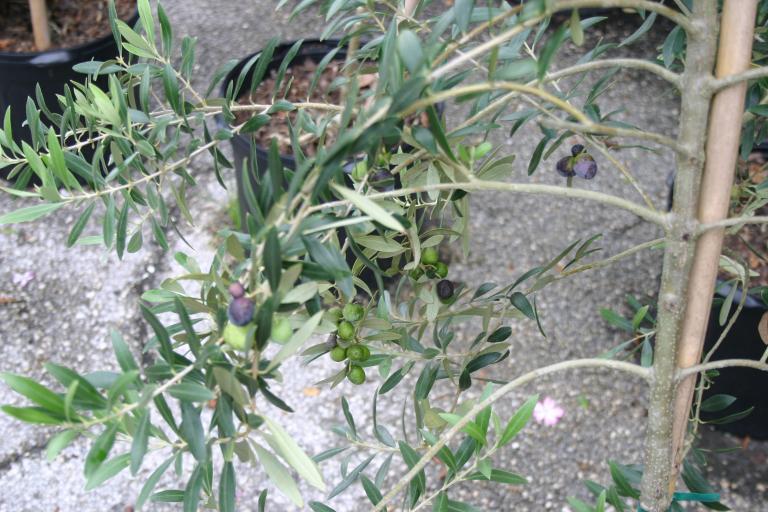

Above three photos: As you can see, some fruit are already ripening on the last day of July. Can you imagine how valuable Florida’s olive crops will be with ripening at least a month earlier than California’s typical harvest date.
Yes, we have lots of green olives on the olive trees that went through the 2013-2014 winter at Quality Green Specialists, Inc. Nursery in DeLand – both in containers and in ground. More proof that you can produce olives in central Florida. The below two photos were taken at QGS’s Nursery in DeLand, FL on April 23, 2014:

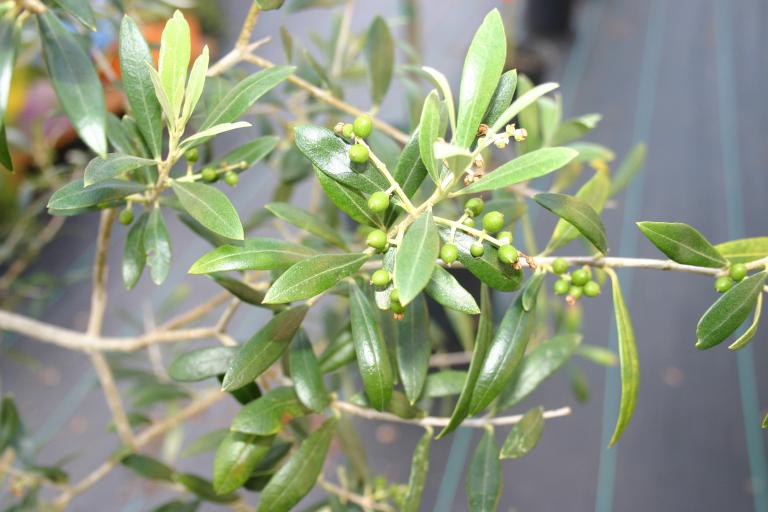
The three photos below taken on March 4, 2014 show numerous bloom heads on the olive trees at QGS, Inc. Nursery.
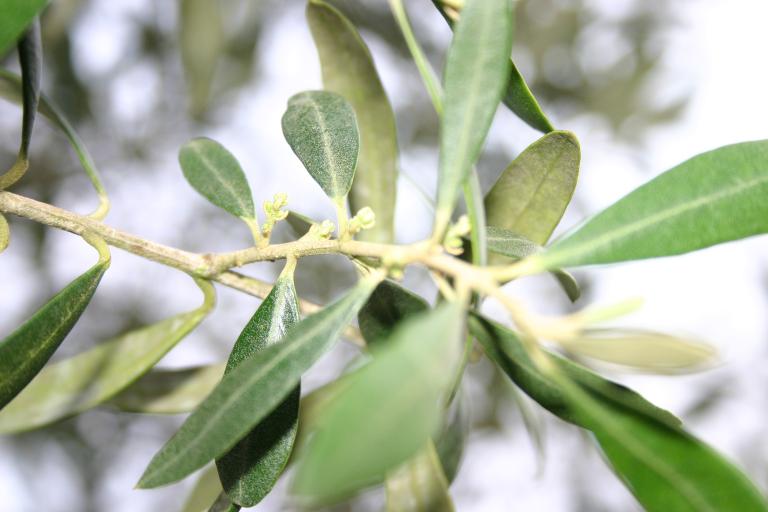

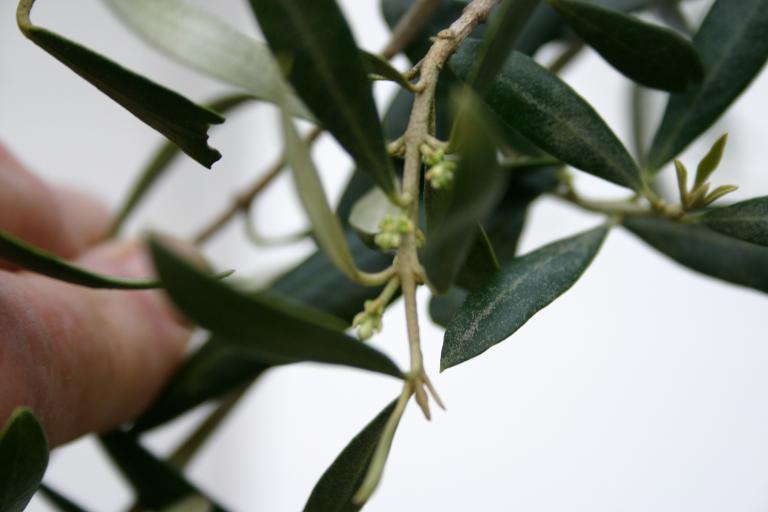
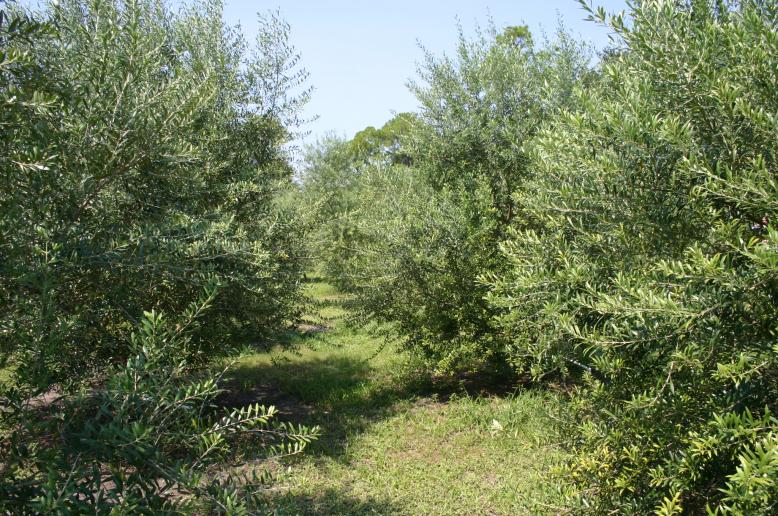
Above photo: Allen Green’s Olive Grove, Port Orange, Fla.
Below are two photos of Jim Tschida’s grove of Arbequina olives in Haines City. Trees were planted in early 2013. Photos taken in February, 2014.


Below is Robin & David Vick’s and Sue Ratay’s olive grove in Ocala, Florida. Grove was started in 2012 from small liners. Photo taken January, 2014.

Below: Olives in nice clusters and sizing up on an olive tree in DeBary, Florida (just north of Orlando) planted by Dana Venrick in 2007. The tree is now about 18 feet tall. It is beautiful and graceful with a semi-weeping appearance. Photo taken May, 2013. As of April, 2014, the grove now has small olives on the trees!
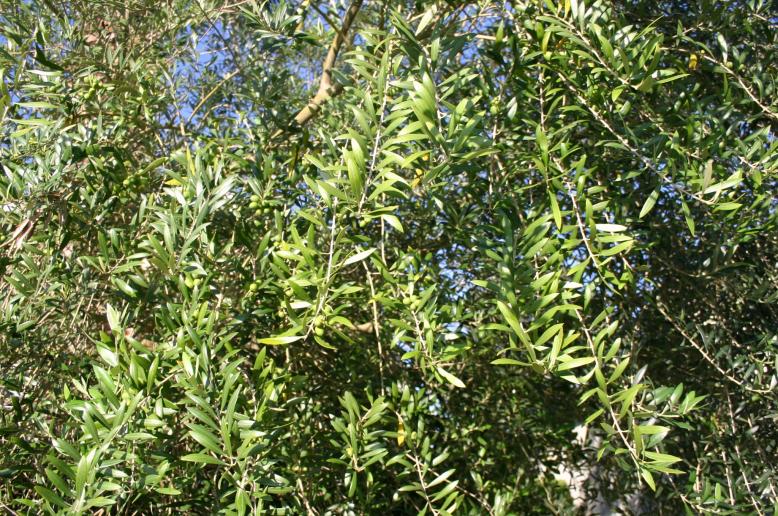
Above: Olive fruit at home in DeBary, Florida (just north of Orlando).
Below: The same tree full of olives on August 8, 2015:
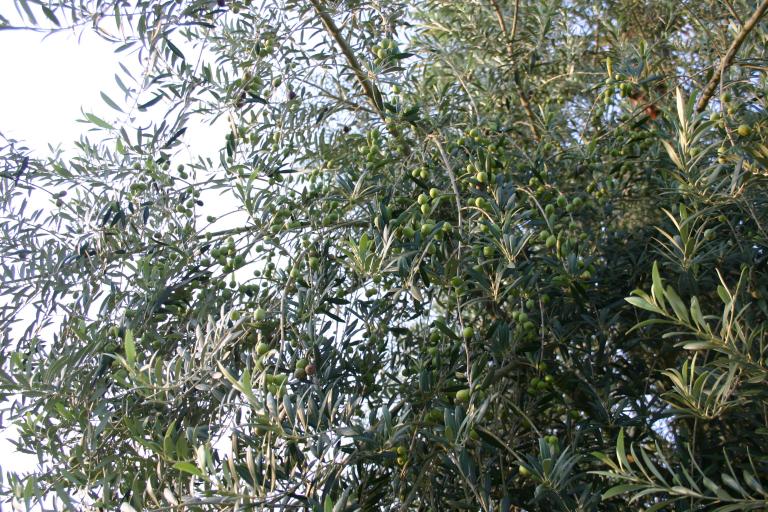
Below: The same tree at home in DeBary showing green olives before turning black. Photo taken on July 17, 2015.
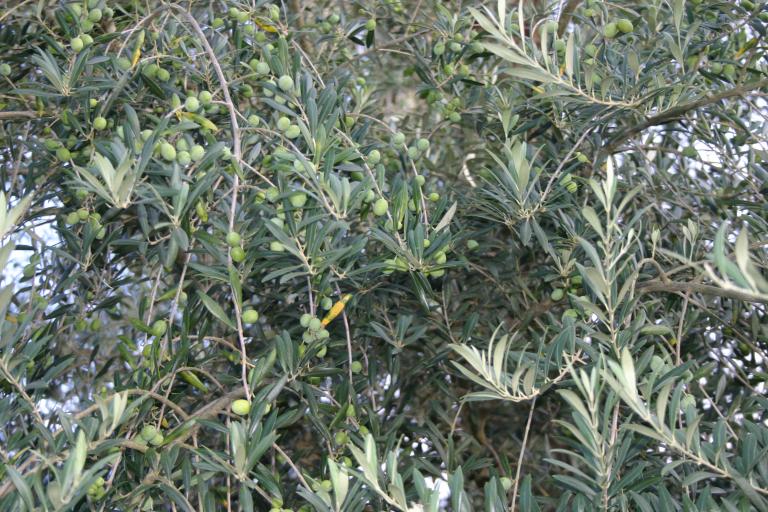
Good News: Tree Shakers work well for harvesting Olives!
According to the May, 2014 issue of Citrus Industry Magazine, an olive grove in Portugal is using a trunk shaker to mechanically harvest olives. According to the grower’s website, http://www.quevedoportwine.com, “We are using a vibration harvester, which shakes the boughs, dislodging the olive fruit in [a] few seconds. It definitely creates some vibration in the trunk, but seems not to affecct the health of the olive tree. We have studied the effects of this harvester and we concluded no major damage was caused to the trees on the weeks and months after the harvest.”
You can see a video of the mechanical harvester in action harvesting olives at:
http://quevedoportwine.com/organic-olive-oil-from-quevedo-using-mechanical-vibrating-harvester/.
You may also see it at the University of Florida mechanical harvesting team’s website at http://citrusmh.ifas.ufl.edu.
Affordably priced trees on sale now at our nursery, 1639 N. Spring Garden Ave., DeLand, FL 32720. Over 1,000 trees now in stock!
* New Olive Production Guide! A complete guide to growing olives by Dana Venrick – an easy to understand, detailed, and well-illustrated “Olive Production” PowerPoint. Email me today and I will email a copy of this excellent detailed guide to growing olives in Central Florida, North Florida, and South Georgia. This is the same PowerPoint I presented at the Small Farms Conference “Agri-tunity” in Bushnell, Florida and many other organizations as well. This presentation has been received with great reviews. This is the best production guide available on growing olives and has over 80 beautiful well organized slides with photographs from Florida, Georgia, California, Spain, Italy, Greece, Morocco, and other locations. It is well documented with citations of research from around the world to include the above locations as well as South Africa, Australia, and Israel.
This PowerPoint can be yours for only $12.95 (plus sales tax). If you prefer, I will mail you a DVD + R. Call or email me today at 386-837-3878 – danavenrick@yahoo.com. Credit cards are accepted.
Quality Green Specialists grows premium quality olive trees. We specialize in large hard-to find liner plants ready for planting for only $7.00. The liners are in 4 ” pots. We currently have many in stock and are extra fancy. We also have a good supply of larger containerized trees for sale. Gallon size trees are affordably priced at $12.00. Large gallon trees (5 ft. tall) are also available: some for $25.00 and some for $35.00. Also available: big 10 gallon trees for $65.00 and bigger 15 gallon trees producing olives for $125.00. Arbequina, a smaller growing cultivar producing the highest quality olive oil, is the recommended variety for planting in Florida and South Georgia. Companion varieties to improve pollination and quality (Arbosana and Koroneiki) are also in stock. For more details and pricing for larger wholesale quantities, contact Dana Venrick at 386-837-3878 or Allen Day at 386-747-0567. Wholesalers: remember to ask for quantity discount. Credit cards are welcome.
We are the Florida Olive Industry specialists. Let us plan and install a highly profitable olive grove for your farm. Our precise, comprehensive recommendations, based on the very best soil and leaf tissue analysis, ensure maximum production and the highest quality oil for premium quality Florida extra virgin olive oil or high quality olive leaf extract. Arbequina, which produces the highest quality olive oil, is the recommended variety for planting in Florida and South Georgia. We specialize in olives and have a large supply in stock. Companion varieties to improve pollination and quality (Arbosana and Koroneiki) are also in stock.
Soil testing and leaf tissue analysis for olive groves, as with other crops, is highly important. Let us perform the tests for you at a reasonable fee or ask us for an instruction sheet if you would like to pull the tests yourself to bring to us for testing, analysis and recommendations. Also, a good souce for information on testing is on the “Olive Oil Source” website at:
http://www.oliveoilsource.com/page/fertilizers-and-amendments
Article in The DeLand Beacon, October 19, 2012:
Could Olives be West Volusia’s Next Big Crop?
By Pat Andrews
Beacon Staff Writer
posted Oct 19, 2012 – 8:50:56am
Text Size
Dana Venrick, retired Volusia County extension agent specializing in commercial horticulture, said he believes there is a future for olives in Volusia County and in most of Florida, though South Florida may not have enough “chill hours” that the fruit needs to mature.
Venrick consulted with Allen Green in Port Orange, planting 10 acres of olive trees at Green’s nursery. Those trees, planted about two-and-a-half years ago, are bearing olives, and a good crop is expected this fall, he said.
Venrick also runs the Quality Green Specialists retail nursery at 1639 N. Spring Garden Ave. in DeLand, where he sells olive trees along with other plants and organic products.
“The trees do quite well here. We’ve had great results,” Venrick said.
The trees like hot summers and cool winters. Once established, they tolerate freezes down to 12 degrees.
Director Dave Griffis of the University of Florida IFAS Extension Office in DeLand said the University of Florida is currently researching olive varieties to see which is best for this climate, and which ones produce enough fruit to make olive-farming economically feasible for the grower.
Griffis said Williams’ grove will be on the 31st annual Farm Tour, Friday, Nov. 16, sponsored by the Extension Office. More information about that event will be printed soon.
The olive orchard has come to West Volusia.
Florida, like California, is at approximately the same latitude as the Mediterranean Basin — and has a similar climate. That fact, along with consumers’ growing passion for healthful eating and healthy living, brought Richard Williams of Florida Olive Systems to a grand experiment: growing an olive grove.
Info box with colored background:
Going for U.S. rather than imported oil
While U.S. olive-oil production has taken off, especially in California, imports still dominate the market. Only about 1 percent of the 250 million liters of oil consumed annually in the U.S. are produced in the U.S.
With olive-oil imports came complaints that the pricey oil was mixed with cheaper canola, safflower or peanut oil to increase profits, and that oil marketed as “virgin,” or first press and highest quality, was not what it was billed.
As a result, the U.S. Department of Agriculture instituted new standards for olive oil in 2010, among them, a prohibition on mixture with oils of other kinds.
Williams said foreign producers are still “dumping” inferior-quality olive oil into the U.S.
Other sources back him up.
A study conducted by the Agricultural Research Service showed polyphenols, which give olive oil its health benefits, are very low in most commercially available olive oils.
The imported oils don’t live up to USDA standards or international standards, another study conducted by the University of California showed. Imported “extra-virgin” olive oils failed to meet standards because of adulteration with cheaper refined olive oil, too-old oil degraded by exposure to light and high temperatures, and oil made from damaged and overripe olives. All these factors reduce the polyphenol content.
Only one sample of U.S.-produced oils failed the tests.
Ken Noren, editor of Olint, a trade magazine, told The Beacon the federal government does not enforce any quality-based standards on imported oil.
“However, standards have been proposed and are moving through rankings of our government very quickly,” he said.
In addition, he noted, the U.S. International Trade Commission, a federal agency, will look into market conditions confronting the U.S. industry, to help ensure its competitiveness with the flow of imported olive oil.
The potential in the U.S. for quality olive oil is huge, Williams said.
Current consumption of the flavorful oil is less than 1 liter per person per year in the U.S., he said. In Italy and Greece, where olive oil is produced fresh from local trees, the consumption is respectively 15 liters and 26.1 liters per person per year.
Maybe there’s gold in that greenish-gold oil.
Williams, who is married to Lisa Ford Williams, said he is grateful to the Ford family for letting him use family land for the experiment. In July, he planted 11,160 olive trees on 20 acres at 1599 Spring Garden Ranch Road, near DeLeon Springs.
“This is extremely experimental,” Williams said.
In West Volusia, only a few trees have been planted here and there, so far. Statewide, probably fewer than 100 acres are planted in olives.
Williams traveled to Texas, California and Georgia to look over successful orchards and gather information in preparation for planting the grove. His young trees came from California.
Going high-tech can help make growing the ancient trees cost-effective. Olive harvesting is traditionally labor-intensive and expensive. Williams’ trees are planted in straight rows and spaced so mechanical harvesters can remove the olives when they’re ready.
The three varieties he’s growing for cross-pollination — Arbosana, Arbequina and Koroneiki — are expected to flower, then bear fruit, in about three years. They will grow into a hedge, Williams said.
Olives are aquifer-friendly crops, requiring little water. They thrive in a fairly dry, moderate climate, and their cold-hardiness has some local citrus growers watching Williams’ operation with keen interest, he said.
West Volusia’s citrus industry has been plagued by freezes, pests and citrus greening disease, and growers are looking for secondary crops as insurance. If Williams’ orchard does well, he will sell citrus growers some olive trees.
He is using drip irrigation, which gives the trees just the amount of water they need: a little bit every day. Drip irrigation feeds the roots only, not spraying the whole area. Olive trees need little fertilization.
“We have two 4-inch wells doing the whole grove,” Williams said.
He’s made no decisions about installing olive-oil production facilities on-site. Williams said he’ll see what happens with his trees first.
June 27, 2012 Update from Michael Garcia:
There is some discussion about olives needing a certain number of “chill hours” to make fruit and some do not consider areas below I-4 appropriate for olives; however, recent USDA experiments in Texas (26° 16″) suggest differently. In our research program, we hope to incorporate several cultivars from north and south Mediterranean areas in test plots up and down the state to determine a best fit for Florida. We are in the process of a final draft of our Florida Olive Research Program proposal and will be vetting the document with academics and industry to ensure we have a rational approach supported by all concerned parties.
Florida Olive Council (FOC) associates report more olive plantings and some issues with frost. Dave Hannah in Live Oak had some cold damage but plants are coming back. Tommy Oleson reports some cold damage at his Hastings grove – but recovering. Tommy is perhaps the most experienced with various cultivars – having worked his grove through thick and thin over the last eight years. Another grower is installing 20 acres of SHD Arbequinas near DeLand and Lykes have a small experimental plot near Lake Wales. We anticipate the Shaw Brothers in Lakeland, GA (30 mi. north of Jasper, FL) will harvest their second crop in September. Don Muller, arguably the oldest modern Florida olive grower will be selling olives and oil from his plantation in Jackson County, FL come November. We will post more information about all Florida Olive activities on the FOC website.
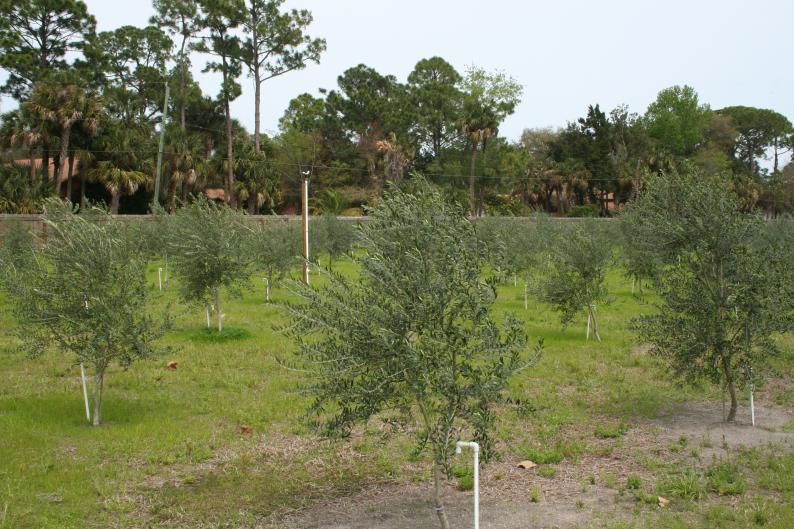
Dana is the pioneer of the Florida Olive Industry in Volusia County, Florida. Allen Green’s pioneering Arbequina olive grove in Port Orange was planted upon the recommendation of Dana and has continued to receive his careful attention. Four months after this photo was taken
(September, 2010) the trees were loaded with olives (photo taken May, 2010).
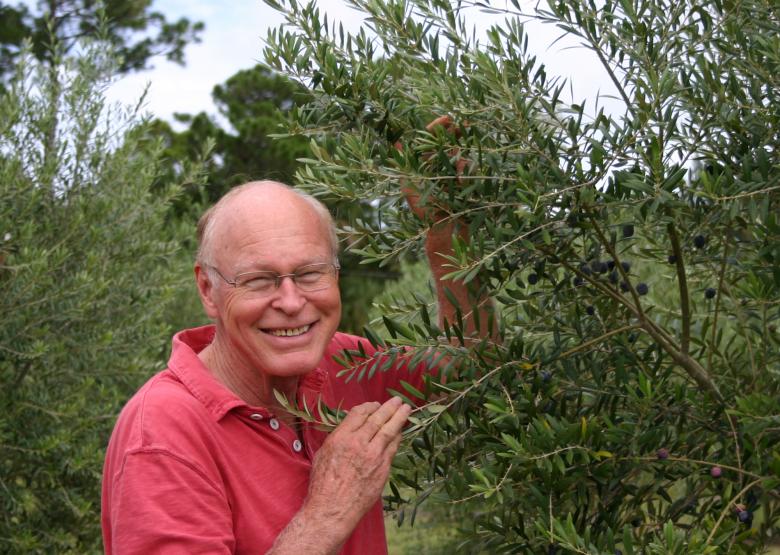
On September 25, 2010 the olive trees were loaded
with ripe (black) olives – one and a half years after
the grove was planted – who said you can’t raise olives
in Florida?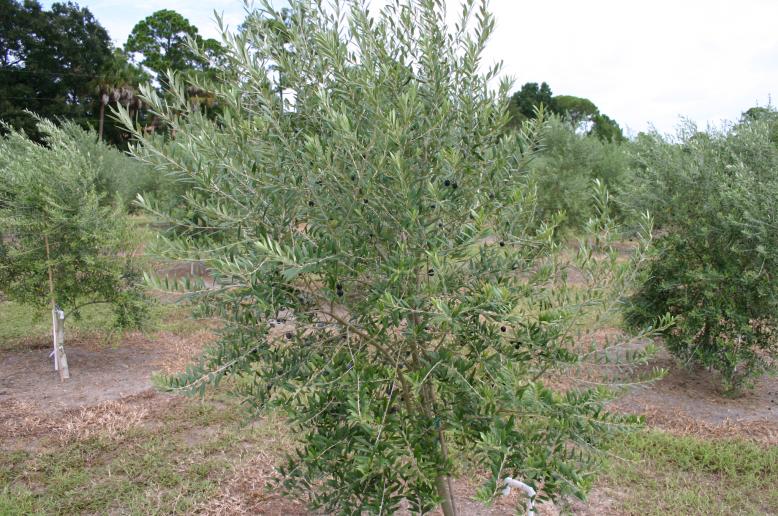
September 25, 2010 – the tree growth from May until September was amazing!
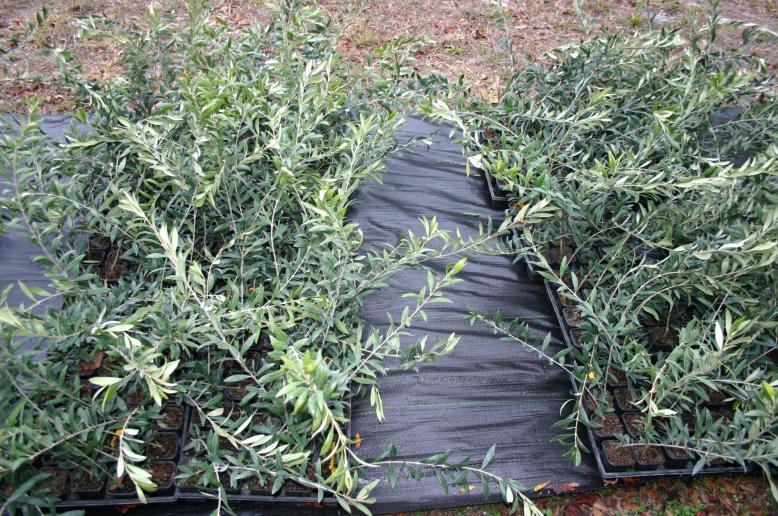
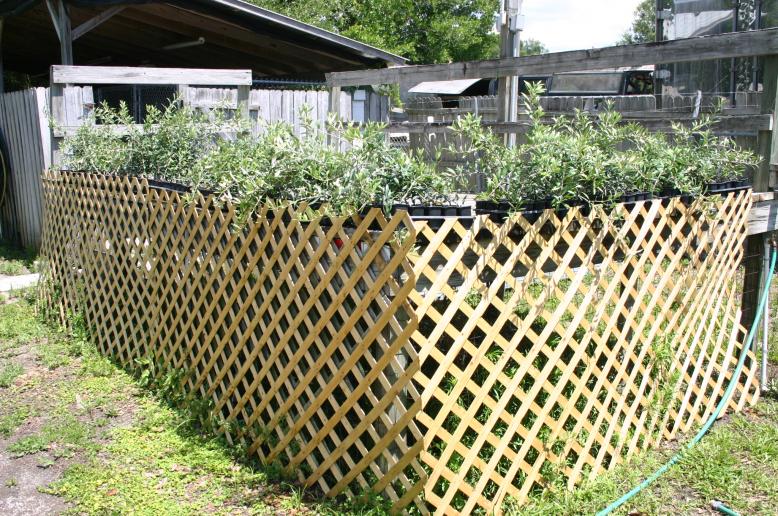
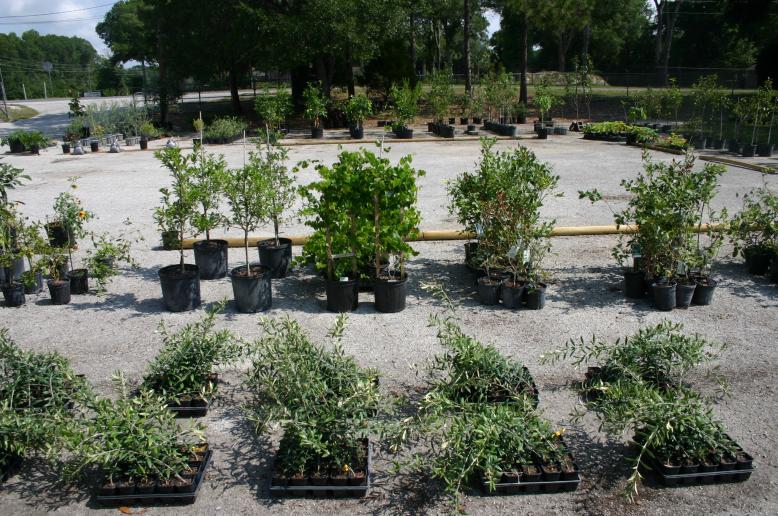
Quality Green Specialists has thousands of Arbequina olive liners in stock along with Arbosana & Koreneiki liners (primarliy used as pollinators). We are committed to serving the olive industry in Florida.

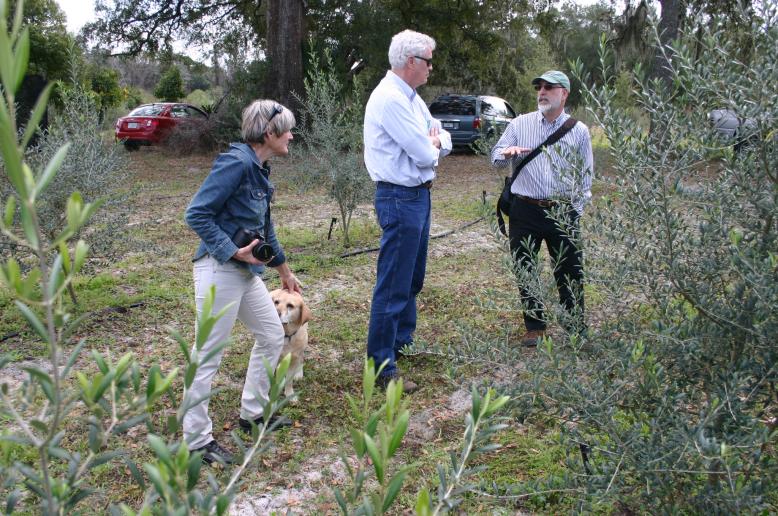
Dana Venrick, Quality Green Specialists, and Dr. Michael McDonough of Ormond Beach were visited by two California and world-wide authorities on olive production, Paul Vossen and Dr. Louise Feruson. Pictured in Dr. McDonough’s new olive grove in Pierson are left to right: Dr. Louise Ferguson, Dr. Michael McDonough, and Paul Vossen. Dana also gave Paul Vossen and Dr. Ferguson a tour of Allen Green’s beautiful olive grove in Port Orange. Paul Vossen is with the University of California Cooperative Extension, Sonoma County and Dr. Ferguson is with the University of California, Davis. Your team at Quality Green Specialists is committed to being your most knowledgeable olive consultants in order to serve you better. Our top notch consulting advice will ensure that your crop of olives and oil will be the very finest quality and will be produced by the most cost-effective methods.
Olive News…..
….Not Virgin Enough !
According to reports from the University of California, Davis, many of the olive oils in stores are not the top grade extra virgin olive oils that their labels claim. Scientists found that 69% of imported oils and 10% of domestic oils sampled did not meet the international standards that define the pure, cold pressed, olive oils that merit the extra-virgin label. Florida finds this a great opportunity to build an extraordinary olive industry producing the best, freshest, authenic, rare Florida extra-virgin olive oil. Imagine how you will savor the taste of the best and freshest oil from from Florida. To read the complete article, scroll to the bottom of the page.
Florida Olive Trees and New Groves:
I am proud to announce a significant breakthrough in the horticultural industry of Florida – we have started of a brand new olive industry. With my encouragement, advice and consultations, a number of growers have planted olive groves in many locations in the state of Florida. Pictured is a grove in Port Orange, a city just south of Daytona Beach not far from the Atlantic Ocean, growing beautifully. Many groves have been started in western Volusia County from Orange City, through DeLand to Pierson (home of the very scenic River of Lakes Scenic Highway and Black Bear Scenic Highways I might add).
Florida Olive Industry Specialists:
As the Florida Olive Industry specialists, let us plan and install a highly profitable olive grove for your farm. Our precise, comprehensive recommendations, based on the very best soil and leaf tissue analysis, ensures maximum production and the highest quality oil for production of premium quality Florida extra virgin olive oil.
Why grow olives and why produce olive oil?
Olive oil is rich in mono-unsaturated fats and contains no cholesterol. Many nutritionists and medical groups including the National Heart Foundation are now recommending olive oil as the healthy substitute for other fats in the diet. Olive oil is the only oil which is actually a fruit juice … in its purest form, the oil is simply ‘squeezed’ from the fruit, filtered and bottled … with no contamination by any chemical processes. Scientifically proven health benefits are a major reason for the world-wide yearly increase in demand for olives and olive oil.
Olive Oil … is actually a fruit juice!
“The modern American, with all his patent contrivances…will never know…a full tide of health until he returns to the proper admixture of olive oil in his diet. Until he again recognizes the value and use of olive oil, he will continue to drag his consumptive-thinned, liver-shrivelled, mummified-skinned, and constipated and pessimistic anatomy about…in a vain search for lost health.”Dr P.E. Remondino, Olive Grower’s Convention, California 1891.
With the help of Quality Green Specialists, olive trees produce high quality olives and oil in Florida!
Olives require a long, hot growing season to properly ripen the fruit, no late spring frosts to kill the blossoms, and sufficient winter chill to ensure fruit set – all conditions that exist in central, north Florida, and some of the the lower part of the southeastern United States. Olive trees in Florida have been established by a number of growers who are pioneers in the field. Some are already beginning to bear fruit using cultural techniques tailored to Florida’s unique soils and climate. An olive growing industry has been established in south Georgia and is now in the fourth year (2013). The first small scale olive harvest in south Georgia was in the fall of 2012.
Freshness and quality are the keys to good olive oil and that is what will make the Florida Olive Industry highly successful in the southeastern United States. Worldwide, we are in the right latitude grograpically with the right balance of hot summers, bright sunshine and warm to cool winters. The variety Arbequina is the olive variety predominately being grown in central Florrida and we have the required chill hours without having temperatures too low to cause tree damage. Olive trees will grow anywhere that citrus trees thrive. They are fertilized much the same as citrus (but only 60 pounds of nitrogen per acre per year compared to 160 pounds or more for citrus, more potassium than nitrogen, and no nitrogen fertilizer after the middle of the summer), like well-drained soil, and are easy to care for. The only caveat is that they don’t like “wet feet” and must be grown in well-drained soil or bedded above the water table.
Quality Green Specialists supplies the finest containerized olive trees available. Nice sized, well-rooted liners are $7.00. Larger 3 gallon trees (approximately 5 ft. tall) are also available for $25.00 & $35.00. Arbequina olive trees, which are the best oil producers, are available in quantity for grove planting. Companion varieties to improve pollination and quality (Arbosana and Koroneiki) are also in stock and ready to plant. For more details on olives and pricing for larger wholesale quantities, contact Dana Venrick at 386-837-3878 or Allen Day at 386-747-0567.
Commercially, olives are not propagated by seed. Trees propagated from seed revert to the original small-fruited wild variety. The seedlings can be grafted with scions from other cultivars. Olive trees can also be top worked. Suckers that grow at the base of mature, desirable trees can be transplanted. Commercially, olives are propagated from cuttings. Twelve to fourteen inch long, one inch wide cuttings from the two year old wood from mature trees are treated with rooting hormone, planted in a light soil-less medium and misted in a propagation house until rooted. There are certain procedures that will improve rooting percentage and reduce the rooting time. Trees grown from cuttings can be grafted with another cultivar. Trees from cuttings bear fruit in three to four years.
Varieties to grow in Florida:
Arbequina – is a small, cold-hardy (to 9 degrees Farenheit with mature trees) Spanish olive introduced to the United States in the mid 1990’s. This variety is one of the earliest to produce fruit, within three years. The olives grow in heavy clusters and have a high oil content. The trees can reach 25 to 35 feet at maturity, but can be trained and kept lower in high density plantings for machine harvesting. The oil is mild, very aromatic, fruity, and sweet. Small percentages of Arbosana and Koroneiki may be grown separately in high density plantings and the oils blended with the Arbequina to increase the quality of the olive oil.
Arbosana – has fruit that looks almost like the Arbequina, but matures three weeks later (mid-season ripening). Arbosana oil is more robust than Arbequina and has a more peppery taste. It has a fruity, nutty flavor, and medium pungency. It also has a higher level of polyphenols – the chemicals that may reduce the risk of heart disease and cancer. Arbosana olives originated in Spain.
Koroneiki – is a very small olive that originated in Greece and is grown for its oil. It has a deliciously robust flavor with a pleasant, peppery finish. The oil is very pungent and is usually grown for blending into Arbequina oil to produce a better, more complex flavor and increase shelf life. Koroneiki olives have a very high level of polyphenols. A drawback to Koroneiki in central and north Florida is that it is cold sensitive. The fruit is also late ripening.
Mission – a Spanish variety introduced to the United States by way of Mexico to a California mission in 1769 is the most cold resistant of the olive varieties. It can survive temperatures as low as 8 degrees. Its fruit is larger than the Arbequina and is born singly or in clusters and also has a high oil content. Trees can reach 40 to 50 feet at maturity. The olives ripen mid-season. Mission and Manzanillo olives are incompatible for pollination purposes. Picked early, the oil is very bitter. Picked mid-season the oil is slightly fruity, bitter, and pungent. Mission is considered mid-season. Picked late the oil is very bland and buttery.
Manzanilla – another Spanish variety introduced to the United States in 1875 with fruit larger than the Arbequina and the olives are born singly. Manzanilla is the most widely grown variety in the world and has very high quality.The trees have a low-spreading growth habit reaching 15 to 30 feet at maturity. The trees are cold sensitive, making them undesirable for central and north Florida. Manzanilla requires a pollinator for good production. Note: Mission and Manzanillo olives are incompatible for pollination purposes. The oil is very aromatic, fruity, and peppery.
Fertilization (better stated as mineralization) is very important in sandy, mineral-poor soils. Having sufficient (very abundant) and “balanced” levels of calcium and magnesium (2-3 times as much calcium as magnesium [a 2:1 ratio] in the soil is an ideal goal) is very important for olive production. Olives like a very alkaline pH of 7.2 to 7.5 or even a little higher, so don’t be afraid of putting on a heavy application of dolomitic limestone (with a 2:1 ratio of calcium to magnesium). Also, olives respond to inputs of nitrogen, phosphorus, especially potassium, manganese, zinc, copper, and boron as needed. Micronutrients as needed in trace mineral-deficient Florida soils is important as well. Part of my mineralization strategy is to apply a “shot gun” application of all trace elements combining liquid kelp (recommended below) with a humic acid product such as our “Vital Green” 3 in 1 Organic liquid fertilizer (or “Super Hume & Seaweed”) and our seaweed based 3-6-9 liquid fertilizer. Depending on soil and summer leaf tissue analysis, additional essential micronutrients testing below optimum levels should be combined with the kelp and humic acid or applied separately, e.g., manganese applied as Mn 6%, or iron applied as “Dark Green” iron both with organic glucoheptonate chelation (recommended) or FeEDDHA chelate for high pH soil (not absorbed as well). Start fertilizing in January or February before bud break. Use both our own dry granular “Super Green” 3-0-5 Fertilizer (with some added bone meal or other phosphorus source in case the soil tests low in phosphorus) on the root zone and a liquid foliar spray of 1/2 “3 in 1” (fish, humic acid, kelp, blackstrap molasses) and 1/2 of our kelp-based “3-6-9” Liquid Fertilizer. Coming soon: Our new “Olive Thrive” liquid fertilizer higher in amino acids from seaweed (kelp), phosphite (PO3-), phosphate (PO4-), energized humate with over 50% fulvic acid, a small amount of nitrogen and higher potassium (never from potassium chloride, also known as muriate of potash, which is very toxic to an olive tree), which will help to ensure consistent spring flowering and fruiting.
Nutrient uptake by mature olives per year is something like: 300 grams nitrogen (N), 75 grams phosphorous (P2O5), and 500 grams potassium (K20). (This is the basis of our 3-0-5 Fertilizer – only add phosphorus every 2 years or so as needed). Precision soil testing that we offer will tell you the exact inputs needed every year and the timing of the applications for maximum benefits. Excessive fertilization causes a drop in oil quality (and perhaps only vegetative growth and no olive fruit!); therefore, testing and following precise input recommendations are of great importance. The best fertilizer recommendations follow both soil testing and a close look at leaf tissue analysis results performed in July. Then precise inputs of fertilizer can be confidently recommended.
Important caution: Olives are sensitive to chlorine, so don’t use water high in chlorine or less than a 2:1 ratio of calcium to chlorine in the irrigation water. A water test is important. Don’t use fertilizers high in chlorine or that contain muriate of potash (the same material as MOP/potassium chloride) for obvious reasons.
Looking at the research, early fertilizer inputs are very important. Boron (B), should be applied as a pre-flowering foliar spray. We recommend KeyBor (glucoheptonate chelated boron) at a low rate. For pollen growth and fruit set growers combine urea and seaweed extracts pre-bloom to achieve the highest yields. For best results in sandy Florida soils, low in trace minerals and highly leachable, my recommendation is to combine the seaweed with some urea and a humic acid product, as mentioned above. All these inputs may be combined for a highly effective pre-bloom application.
Potassium (K) is best applied in late winter (pre bud-break along with kelp), spring, and summer (along with kelp). Regular K inputs maximize yield and quality. Do not apply K (or N) after July.
Phosphorous (P) – Incorporate P into the soil only if it is needed. Some growers apply P fertilizer (depending on testing results) only once every two to three years. My recommendation is to make a light application of P every year while monitoring to avoid an excessive P build-up in the soil. Then stop applying when P reaches an optimum level in the soil. Resume as needed in 2-3 years based on soil testing. Quality Green Specialists tests for P in two different ways – Mehlich III and Bray I to optimize soil management. Not only can we tell you the total P, but also the amount potentially available and the amount in the soil that is unavailable.
Nitrogen (N) is important for growth, flowering, and fruit set and should be watered in after application. Apply 2/3 of the total nitrogen (37.5 lbs/ac) before flower bud differentiation and before new growth begins. Then apply 1/3 (12.5 lbs/ac) during the flowering stage. N can be applied as a ground application, a foliar spray, or by fertigation (recommend at least a ground application and a liquid foliar application). N applied early and in optimum amounts increases fruit set significantly.
Magnesium (Mg) – Make sure Mg is applied as needed and is available in the soil. Magnesium is available from dolomitic limestone (calcium magnesium carbonate), but is not an option in very high pH soils. In high pH situations or with an extreme ratio of high calcium to lower magnesium (over 11:1), liquid applications of Epsom Salt (magnesium sulfate) may be necessary on a regular basis (as well as organically chelated trace minerals to avoid a high pH sequestion (tie up). Avoid high levels of both P (especially keep phosphorus low) and Mg in the soil as they tie each other up in the soil; consequently, uptake of both are inhibited.
The bottom line is to make low “balanced” inputs that include low nitrogen and higher potassium and phosphorus if testing indicates a phosphorus deficiency (never try to “push” the trees) early in the year up until the middle of July, based on regular testing with high importance being placed on summer leaf tissue analysis. Never fertilize olive trees from the middle of July through December. This is important to make trees very tolerant of possible freezes and one of the practices necessary to convert olive trees from a “growing mode” to a “fruiting mode”. Azomite® volcanic mineralizer, with bio-available silicon as silicon dioxide, potassium, calcium, and magnesium, and all other necessary trace minerals at desirable very low levels, is an important amendment to be applied in the fall to further promote cold hardiness, and bloom and fruit set in the spring. Also necessary is a light ground fertilizer application in January or February (before bud break) (based on 2/3 of the nitrogen (N) needed for the year or 37.5 pounds of N per acre [lbs/ac] of rooting area) before bud break like our SUPER GREEN 3-0-5 fertilizer that is modified based on soil and leaf tissue analysis (this plus a foliar spray including urea should total 37.5 lbs/ac of N before bud break). Because our 3-0-5 fertilizer is virtually 4% N, apply 937.5 lbs/ac of actual root zone (provides 37.5 lbs/ac of N). If potassium is sufficient in the soil, another option is to apply 85 lbs/ac of sulfur coated urea (43-44% nitrogen) per acre of root zone (provides 37.4 lbs/ac of N). Another option, besides our 3-0-5 fertilizer if K is low, is to apply 85 lbs of sulfur coated urea (providing 37.4 lbs/ac of N) and potassium magnesium sulfate (22% potassium) at a rate of 273 lbs/ac (providing 60 lbs/ac of K per acre of root zone). Then during flowering apply 312.5 lbs/ac of root zone of 3-0-5 (providing 12.5 lbs/ac of N) or 23 lbs/ac of sulfur coated urea (provides 12.5 lbs of N) and 91 lbs/ac of potasssium magnesium sulfate, providing 20 lbs/ac of potassium. Note that this is close to the desired 3:5 ratio of N to K. The above recommendations are correct only for the non-mineral N that is highly leachable and is not retained as available nitrogen in the soil water; recommendations for potassium, as well as other minerals, is not intended to be a standard practice. The inputs should only be based on site-specific soil testing (because the soil will already hold varying levels of essential minerals) to determine the precise levels of potassium, magnesium, micronutrients, etc. in the soil. Who does the best soil testing, leaf tissue analysis, and recommendations for a program for the year? We do!
Call today to learn how to become a grower of premium olives in Florida.
Dana Venrick
Phone: (386) 837-3878
Fax: (386) 279-7878
Email: danavenrick@yahoo.com
Allen Day
(386) 747-0567
Fax: (386) 279-7878
Email: daylite2@yahoo.com
Want to bottle and label your own olive oil? Go to the olive oil source web site below
for a wide selection of sources for olive oil bottles and labels. Lots of other information about olives and olive oil as well:
Most imported extra virgin olive oils do not meet standards (continued from top of the page):
Researchers at the University of California, Davis and in Australia have found that many extra virgin olive oils are not.
The research team found that 69 percent of the imported oils sampled, compared with just 10 percent of the California-produced oils sampled, failed to meet internationally accepted standards for extra virgin olive oil.
The new study, the first of its kind by an American academic institution, examined olive oils labeled as extra virgin, and purchased in California supermarkets and “big box” retail outlets. A report detailing the study’s findings and the names of the brands evaluated is being released today by the UC Davis Olive Center and is available online at olivecenter.ucdavis.edu/.
“The intent of the study was to provide consumers and retailers with an accurate picture of the quality of olive oils now being marketed through grocery stores and other retail outlets in California,” said Dan Flynn, executive director of the UC Davis Olive Center.
“Our hope is that these findings will lead to improved methods for evaluating extra virgin olive oil, and increased consumer confidence that ‘extra virgin’ on the label means extra virgin in the bottle,” he said.
Extra virgin olive oils, which command a premium price in the marketplace, must be extracted from the olive without heat or solvents, unlike cheaper refined oils. International and U.S. Department of Agriculture standards also require that extra virgin olive oils meet specific criteria for chemical makeup and sensory qualities including flavor and aroma.
“Before this study, we had anecdotal reports of poor quality olive oil being sold as extra virgin,” said Dan Flynn, executive director of the Olive Center. “Now there is empirical proof.”
“The oils that failed in our tests had defects such as rancidity — many of these oils just did not taste good,” he said.
Flynn noted that the defective samples failed the extra virgin standards for one or more of these reasons:
• oxidation due to elevated temperature, light and or aging;
• adulteration with cheaper refined olive oil; and
• poor-quality oils made from damaged and overripe olives, processing flaws or improper oil storage.
The study also revealed that the analytical chemistry methods established by the International Olive Council and USDA often do not detect defective oils that fail extra virgin sensory standards. The researchers found that the chemistry methods used in Australia and Germany were more effective in confirming negative sensory tests.
The Olive Center initiated this study to investigate widely publicized, but unconfirmed, reports that olive oils labeled as extra virgin and imported from abroad for sale in the United States are actually lower quality olive oils.
Extra virgin is the highest grade of olive oil, according to standards set by USDA and the International Olive Council, an international, intergovernmental organization that deals with issues involving olives and olive oil.
The council, established by the United Nations, includes countries that produce 98 percent of the world’s table olives and olive oil.
The United States is not a member of the council; however olive oil produced in the U.S. must meet recently adopted USDA olive oil standards, which closely correspond to the international standards and will go into effect on Oct. 25. The standards include specifications for the grades of extra virgin, virgin, refined olive oil and olive oil, which is a blend of virgin and refined olive oils.
To be considered extra virgin, the oils must meet very specific chemistry-based criteria, have no sensory defects, and contain some fruitiness in their flavor and aroma.
Extra virgin olive oil can be adulterated by mixing extra virgin with cheaper refined oils such as hazelnut oil or with a cheaper refined olive oil, making the adulteration more difficult to chemically detect.
The UC Davis/Australia study:
During one week, beginning March 3, 2010, the researchers bought 14 imported brands and five California-produced brands of olive oil that were being sold under extra-virgin labels at retail stores. The imported samples were purchased from three California regions: Sacramento, the San Francisco Bay Area and Los Angeles County.
The California brands were found only in the Sacramento and San Francisco Bay areas.
Three bottles of each imported brand and two bottles of each California brand were sent to the Australian Oils Research Laboratory in New South Wales, where the oils were put through sensory and chemical tests specified by the international Olive Council and also were analyzed using methods adopted in Germany and Australia.
Directing the sensory analysis at the Australian lab was Rodney Mailer, an expert on oils and oil crops who has been involved with olive research since 1996.
Chemical analyses also were conducted at the UC Davis Olive Oil Chemistry Laboratory, in most cases using bottles with the same lot numbers as those tested in Australia. Edwin Frankel, one of the world’s leading authorities on oxidation of fats and oils, led the UC Davis analyses in collaboration with Charles Shoemaker, co-chair of the UC Davis Olive Center, and Olive Center chemist Selina Wang.
Funding for the study was provided by Corto Olive, California Olive Ranch and the California Olive Oil Council.
Olives in Florida is idea whose time has come. Thousands of olive trees have been planted in Florida during the past year.
Yield: The yield by existing methods is around 450 gallons per acre with high density planting of trees 8′ apart in the rows and 15′ between the rows. This assumes 9 tons of olives per acre in a mature grove with best management practices and 50 gallons of oil per ton. I am confident with better nutrition including the use of Azomite – the great volcanic pumace, that is an achievable target in central Florida to south Georgia. A plus in central/north central Florida is that we can beat Georgia to the market by 2 weeks and California by 4 weeks with the outstanding Arbequina clone that we have – IRTA 1-18. As a Boutique, Estate bottled olive oil, the value should average $75 per gallon. and return $15,000 per acre after expenses. Some cash flow return in 3 years can be expected with good profits with in 4-5 years and big profits with full production in 8-10 years. Olive trees in Georgia were first harvested in the third year and packed out 2 1/2 tons per acre in the fourth year. If sold wholesale to a mill, the return would be about $24 per gallon and return about $3,000 per acre (2.5 tons per acre times 50 gallons per acre = 125 gallons of oil times times $24.00 per gallon = a gross return of $3,000) as a start to much more lucrative returns for years to come. The same production on 10 acres if in-house marketed would return 2.5 tons per acre times 50 gallons per acre = 125 gallons of oil times $75.00 per ton = $9,375 per acre times 10 acres = $93,750 on 10 acres as a healthy start to many years of increased production and profits. The Georgia Olive Growers Association has an olive oil processing mill near Lakeland, Ga. Also, as of late 2015, an olive mill is also in operation near Ocala in north central Florida.
If sold “wholesale” it takes 50 acres to be quite profitable – 5 acres if sold privately as Estate bottled Extra Virgin olive oil. The good news is that it is easy to extract 90% of the oil from the olives, which is the most valuable grade: extra virgin. Can you imagine the value of the best, fresh, locally produced Extra Virgin Olive Oil “Fresh from Florida”?
The olive fruit fly is not here and California is very strict on anything that leaves the state, so it may be a long time if ever that we have the fruit fly. However, we are ready with a good selection of combination oil sprays including neem oil, if rotated, are quite effective.
The only problem we have after 10 years of experience here is the scale insect and it is easy to control with various oil-based sprays.
Below is more information about the best Arbequina I-18 clone which we grow and have in stock:
ARBEQUINA CLONE I-18®
This variety owes its name to the region called Arbeca in Catalonia. It is believed that it was brought there during the Middle Ages from the Mediterranean island of Majorca, birthplace of the California padres.
These oils are highly valued in both the national and international markets for their excellent organoleptic qualities. Traditionally, a high percentage of these oils has been exported to other countries (especially Italy) to fortify other olive oils. In recent years, the Arbequina has been the most widely planted olive variety around the world and is spreading fast to different countries.
The popularity of this variety can be attributed to the good sensory characteristics of its virgin oils and also to its agricultural advantages. It is a highly productive rural tree that bears fruit quickly, and it is also compact, which allows one to plant the trees more densely. It adapts well to poor terrain and is resistant to cold. It is also self-fertile. Its fruits ripen in stages, are small, spherical, and appear in clusters.
The oils of this variety stand out as being fruity, sweet, with apple, green grass, and almond aromas.
Detail of the selection process
which yielded the clonal selection IRTA I-18
110 individual trees selected from orchards across Spain for processing superior traits (1986)
Four years later
15 advanced selections identified as possessing superior
production and uniformity in ripening
Two years later
Advanced selections propagated vegetatively
and placed into replicated trials
Five years later
Arbequina IRTA I-18 released for its superior
traits above all other known Arbequina clones (1997)
Click here to see the “Comparison of agronomic and chemical characteristics of standard Arbequina variety and its clone I-18® (sixth leaf)”
The Arbequina clone I-18 possesses the following advantages relative to the standard variety:
- Heavier initial bearing
- Higher productivity (25% more production)
- More uniform ripening
- More upright habit (semi-erect)
This information has been supplied by the I.R.T.A. (Institute of Research and Agronomic Technologies).
Researchers at the University of California, Davis and in Australia have found that many extra virgin olive oils are not.
The research team found that 69 percent of the imported oils sampled, compared with just 10 percent of the California-produced oils sampled, failed to meet internationally accepted standards for extra virgin olive oil.
The new study, the first of its kind by an American academic institution, examined olive oils labeled as extra virgin, and purchased in California supermarkets and “big box” retail outlets. A report detailing the study’s findings and the names of the brands evaluated is being released today by the UC Davis Olive Center and is available online at olivecenter.ucdavis.edu/.
“The intent of the study was to provide consumers and retailers with an accurate picture of the quality of olive oils now being marketed through grocery stores and other retail outlets in California,” said Dan Flynn, executive director of the UC Davis Olive Center.
“Our hope is that these findings will lead to improved methods for evaluating extra virgin olive oil, and increased consumer confidence that ‘extra virgin’ on the label means extra virgin in the bottle,” he said.
Extra virgin olive oils, which command a premium price in the marketplace, must be extracted from the olive without heat or solvents, unlike cheaper refined oils. International and U.S. Department of Agriculture standards also require that extra virgin olive oils meet specific criteria for chemical makeup and sensory qualities including flavor and aroma.
“Before this study, we had anecdotal reports of poor quality olive oil being sold as extra virgin,” said Dan Flynn, executive director of the Olive Center. “Now there is empirical proof.”
“The oils that failed in our tests had defects such as rancidity — many of these oils just did not taste good,” he said.
Flynn noted that the defective samples failed the extra virgin standards for one or more of these reasons:
• oxidation due to elevated temperature, light and or aging;
• adulteration with cheaper refined olive oil; and
• poor-quality oils made from damaged and overripe olives, processing flaws or improper oil storage.
The study also revealed that the analytical chemistry methods established by the International Olive Council and USDA often do not detect defective oils that fail extra virgin sensory standards. The researchers found that the chemistry methods used in Australia and Germany were more effective in confirming negative sensory tests.
The Olive Center initiated this study to investigate widely publicized, but unconfirmed, reports that olive oils labeled as extra virgin and imported from abroad for sale in the United States are actually lower quality olive oils.
Extra virgin is the highest grade of olive oil, according to standards set by USDA and the International Olive Council, an international, intergovernmental organization that deals with issues involving olives and olive oil.
The council, established by the United Nations, includes countries that produce 98 percent of the world’s table olives and olive oil.
The United States is not a member of the council; however olive oil produced in the U.S. must meet recently adopted USDA olive oil standards, which closely correspond to the international standards and will go into effect on Oct. 25. The standards include specifications for the grades of extra virgin, virgin, refined olive oil and olive oil, which is a blend of virgin and refined olive oils.
To be considered extra virgin, the oils must meet very specific chemistry-based criteria, have no sensory defects, and contain some fruitiness in their flavor and aroma.
Extra virgin olive oil can be adulterated by mixing extra virgin with cheaper refined oils such as hazelnut oil or with a cheaper refined olive oil, making the adulteration more difficult to chemically detect.
The UC Davis/Australia study:
During one week, beginning March 3, 2010, the researchers bought 14 imported brands and five California-produced brands of olive oil that were being sold under extra-virgin labels at retail stores. The imported samples were purchased from three California regions: Sacramento, the San Francisco Bay Area and Los Angeles County.
The California brands were found only in the Sacramento and San Francisco Bay areas.
Three bottles of each imported brand and two bottles of each California brand were sent to the Australian Oils Research Laboratory in New South Wales, where the oils were put through sensory and chemical tests specified by the international Olive Council and also were analyzed using methods adopted in Germany and Australia.
Directing the sensory analysis at the Australian lab was Rodney Mailer, an expert on oils and oil crops who has been involved with olive research since 1996.
Chemical analyses also were conducted at the UC Davis Olive Oil Chemistry Laboratory, in most cases using bottles with the same lot numbers as those tested in Australia. Edwin Frankel, one of the world’s leading authorities on oxidation of fats and oils, led the UC Davis analyses in collaboration with Charles Shoemaker, co-chair of the UC Davis Olive Center, and Olive Center chemist Selina Wang.
Funding for the study was provided by Corto Olive, California Olive Ranch and the California Olive Oil Council.
We are the Florida Olive Industry specialists. Let us plan and install a highly profitable olive grove for your farm. Our precise, comprehensive recommendations, based on the very best soil testing and leaf tissue analysis, ensure maximum production and the highest quality premium oil for Florida or Georgia extra virgin olive oil. Arbequina, which produces the highest quality olive oil, is the recommended variety for planting in Florida and South Georgia. We specialize in olives and have a large supply in stock. Companion varieties to improve pollination and quality (Arbosana and Koroneiki) are also in stock.
Your olive specialists,
Dana Venrick
(386) 837-3878
Email: danavenrick@yahoo.com
Allen Day
(386) 747-0567
Email: daylite2@yahoo.com
Florida Olive Oil Update: June 5, 2011:
Olives in the southeast are an important crop that will grow and increase in value for years to come. We have supplied trees for groves in Pierson, DeLand, Lake Wales, Dade City, Oak Hill, Port Orange, Alachua, Haines City, Winter Haven, and other locations to include Georgia.
If sold directly to olive mills, it will take 50 acres to be quite profitable – 5 acres for local channels of Estate Extra Virgin olive oil. It is easy to extract 90% of the oil from the olives, which is the most valuable extra virgin oil. Can you imagine Extra Virgin Olive Oil, Fresh from Florida or Georgia? Think estate bottled, boutique Florida or Georgia green sunshine in a bottle!
Young trees grow out very quickly and are reasonably priced. We have nice liners in 4 ” pots for $7. Liners are hard to find, so call and reserve your olive trees while supply is good.
The olive fruit fly is not here and California is very strict on anything that leaves the state, so it may be a long time if ever that we have the fruit fly. Plus, the fruit fly does not appear to like the Arbequina variety of oilive! However, we are ready with a great new natural pesticide called Outbound™. It has a great combination of natural oils, including Neem, and other natral ingredients. It is very effective against all types of insects and has a long residual. The only problem we have seen after 10 years of experience with olive trees in Florida is the scale insect and it is easy to control.
Below is more information about our great Arbequina olive variety.
ARBEQUINA CLONE I-18®
This variety owes its name to the region called Arbeca in Catalonia. It is believed that it was brought there during the Middle Ages from the Mediterranean island of Majorca, birthplace of the California padres.
These oils are highly valued in both the national and international markets for their excellent organoleptic qualities. Traditionally, a high percentage of these oils has been exported to other countries (especially Italy) to fortify other olive oils. In recent years, the Arbequina has been the most widely planted olive variety around the world and is spreading fast to different countries.
The popularity of this variety can be attributed to the good sensory characteristics of its virgin oils and also to its agricultural advantages. It is a highly productive rural tree that bears fruit quickly, and it is also compact, which allows one to plant the trees more densely. It adapts well to poor terrain and is resistant to cold. It is also self-fertile. Its fruits ripen in stages, are small, spherical, and appear in clusters.
The oils of this variety stand out as being fruity, sweet (almost buttery), with apple, green grass, and almond aromas.
Detail of the selection process
which yielded the clonal selection IRTA I-18
110 individual trees selected from orchards across Spain for processing superior traits (1986)
Four years later
15 advanced selections identified as possessing superior
production and uniformity in ripening
Two years later
Advanced selections propagated vegetatively
and placed into replicated trials
Five years later
Arbequina IRTA I-18 released for its superior
traits above all other known Arbequina clones (1997)
Click here to see the “Comparison of agronomic and chemical characteristics of standard Arbequina variety and its clone I-18® (sixth leaf)”
The Arbequina clone I-18 possesses the following advantages relative to the standard variety:
- Heavier initial bearing
- Higher productivity (25% more production)
- More uniform ripening
- More upright habit (semi-erect)
This information is from the I.R.T.A. (Institute of Research and Agronomic Technologies).
California is the biggest producer of olive oil in the United States. Florida, with its ideal climatic conditions, has incredible potential to grow to challenge California as the biggest producer in the United States! For more information about the California olive industry, go to:
http://ucanr.org/sites/uccemarin/files/30471.pdf
To join the Florida Olive Council go to:
http://www.floridaolivecouncil.org
To visit the California Olive Oil Council site go to:
http://cooc.com/
For the new USDA standards for olive oil, go to:
http://www.ams.usda.gov/AMSv1.0/getfile?dDocName=STELDEV3011889
Quality Green Location and Mailing Address:
Quality Green Specialists, Inc.
1639 N. Spring Garden Ave.
DeLand, FL 32720
Driving Directions:
We are located in the beautiful “Tree City” of DeLand, Florida in the northwest part of the city. From Interstate 4, take S.R. 44 toward DeLand to the west. Drive just past the beautiful and historic downtown and turn right or north on Spring Garden Ave. (Hwy. 15-A) and you will find us on the right (east side) at 1639 North Spring Garden Avenue, DeLand, FL 32720 (at the corner of Greens Dairy Rd. on the right). From the south, take U.S. Hwys. 17-92 to DeLand, then take a left on Spring Garden Ave. (Hwy. 15-A). From Pierson and DeLeon Springs, take U.S. Hwy 17 south to DeLand, then bear right on Spring Garden Ave. We are on the left on the corner of Greens Dairy Road and Spring Garden Ave.
Our store hours are 8 a.m. to 5:00 p.m. Monday – Saturday (or by appointment):
Contact Us Today,
Dana Venrick: 386-837-3878 Fax: 386-734-8000
Email: danavenrick@yahoo.com
Allen Day: 386-747-0567
Email: daylite2@yahoo.com
Links:
BELOW: Growing a new crop of one gallon Arbequina Olives.
Olives grow fast. Olives like this…..are soon…………..(see below)

Like this:
